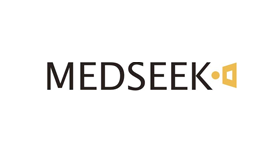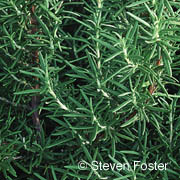Rosemary
Rosmarinus officinalis
Rosemary (Rosmarinus officinalis) is widely used as a spice when cooking, especially in Mediterranean dishes. It is also used for fragrance in soaps and cosmetics. Traditionally, rosemary has been used medicinally to:
- Improve memory
- Relieve muscle pain and spasm
- Stimulate hair growth
- Support the circulatory and nervous systems
It is also believed to increase menstrual flow, act as an abortifacient (causing miscarriage), increase urine flow, and treat indigestion. Almost none of these uses have been studied scientifically in humans. However, one study in humans found that long-term daily intake of rosemary prevents thrombosis.
In the lab, rosemary has been shown to have antioxidant properties. Antioxidants can neutralize harmful particles in the body known as free radicals, which damage cell membranes, tamper with DNA, and even cause cell death. Also in the lab, rosemary oil appears to have antimicrobial properties (killing some bacteria and fungi in test tubes). It isn't known whether rosemary would have the same effect in humans.
IndigestionRosemary leaf is used in Europe for indigestion (dyspepsia) and is approved by the German Commission E, which examines the safety and efficacy of herbs.
Muscle and joint painApplied topically (to the skin), rosemary oil is sometimes used to treat muscle pain and arthritis and improve circulation. It is approved by the German Commission E for these purposes. However, there is no scientific evidence that it works.
AlopeciaHistorically, rosemary has been used to stimulate hair growth. In one study of 84 people with alopecia areata (a disease in which hair falls out, generally in patches), those who massaged their scalps with rosemary and other essential oils (including lavender, thyme, and cedarwood) every day for 7 months experienced significant hair regrowth compared to those who massaged their scalps without the essential oils. But the study was not well designed, and it is impossible to say whether rosemary caused the hair growth.
Neutralize food-borne pathogensSeveral studies show that rosemary inhibits food-borne pathogens like Listeria monocytogenes, B. cereus, and S. aureus.
Improve memory or concentrationRosemary is often used in aromatherapy to increase concentration and memory, and to relieve stress. One study suggests that rosemary, combined with other pleasant-smelling oils, may lower cortisol levels and help reduce anxiety. Another study found that the use of lavender and rosemary essential oil sachets reduced test taking stress in graduate nursing students.
CancerSeveral studies suggest that rosemary extract may inhibit tumor growth by preventing cancerous cells from replicating. One study found that rosemary, on its own and in combination with curcumin, helped prevent breast cancer. A second study found similar effects of rosemary on colon cancer cells.
Plant Description
Native to the Mediterranean area, rosemary now grows widely in other parts of the world. It thrives in a warm and sunny climate. The plant takes its name from rosmarinus, a Latin term meaning "sea dew." It is an upright evergreen shrub that can grow to a height of 6 and a half feet. The woody rootstock bears rigid branches with fissured bark. The long, needle-like leaves are dark green on top and pale beneath. Both the fresh and dried leaves are aromatic. The small flowers are pale blue. The leaves and parts of the flowers contain volatile oil.
What's It Made Of?
The leaves and twigs of the rosemary plant are used for culinary and medicinal purposes.
Available Forms
- Dried whole herb
- Dried, powdered extract (in capsules)
- Preparations made from fresh or dried leaves, such as alcohol tinctures, teas, and liquid extract
- Volatile oil (to be used externally, not orally)
How to Take It
PediatricBecause rosemary has not been studied in children, it is not recommended for medicinal use in those under age 18. It is safe to eat as a spice in food, however.
AdultRosemary can be used as a tea made from the dry herb, a tincture, fluid extract, decoction for a bath, or as an essential oil mixed with other oils for topical use. Speak to your doctor to find the right dose for your condition. Total daily intake should not exceed 4 to 6 grams of the dried herb. DO NOT take rosemary oil orally.
Precautions
The use of herbs is a time-honored approach to strengthening the body and treating disease. However, herbs can trigger side effects and interact with other herbs, supplements, or medications. For these reasons, you should take herbs with care, under the supervision of a health care provider.
Rosemary is generally considered safe when taken in recommended doses. However, there have been occasional reports of allergic reactions. Because of their volatile oil content, large quantities of rosemary leaves can cause serious side effects, including vomiting, spasms, coma and, in some cases, pulmonary edema (fluid in the lungs).
Because higher doses of rosemary may cause miscarriage, pregnant and nursing women should not take rosemary as a supplement. But it is safe to eat as a spice in food.
People with high blood pressure, ulcers, Crohn's disease, or ulcerative colitis should not take rosemary.
Rosemary oil can be toxic if ingested and should never be taken orally.
Possible Interactions
Antiplatelet and anticoagulant drugs (blood thinners)Rosemary may affect the blood's ability to clot. It could interfere with any blood-thinning drugs you are taking, including:
- Warfarin (Coumadin)
- Clopidogrel (Plavix)
- Aspirin
Rosemary may interfere with the action of ACE inhibitors taken for high blood pressure, including:
- Captopril (Capoten)
- Elaropril (Vasotec)
- Lisinopril (Zestril)
- Fosinopril (Monopril)
Rosemary can act as a diuretic, raising your risk of dehydration. It can increase the effects of diuretic drugs, including:
- Furosemide (Lasix)
- Hydrochlorothiazide
Because of its diuretic effects, rosemary might cause the body to lose too much water, and the amount of lithium in the body can build up to toxic levels.
DiabetesRosemary may alter blood sugar levels and could interfere with drugs taken to control diabetes.
Supporting Research
Angioni A, Barra A, Cereti E, et al. Chemical composition, plant genetic differences, antimicrobial and antifungal activity investigation of the essential oil of Rosmarinus officinalis L. J Agric Food Chem. 2004;52(11):3530-3535.
Atsumi T, Tonosaki K. Smelling lavender and rosemary increases free radical scavenging activity and decreases cortisol level in saliva. Psychiatry Res. 2007;150(1):89-96.
Bakirel T, Bakirel U, Keles OU, Ulgen SG, Yardibi H. In vivo assessment of antidiabetic and antioxidant activities of rosemary (Rosmarinus officinalis) in alloxan-diabetic rabbits. J Ethnopharmacol. 2008;116(1):64-73.
Blumenthal M, Goldberg A, Brinckmann J. Herbal Medicine: Expanded Commission E Monographs. Newton, MA: Integrative Medicine Communications; 2000:326-329.
Cattaneo L, Cicconi R, Mignogna G, et al. Anti-ProLiferative effect of Rosmarinus officinalis L. extract on human melanoma A375 cells. PLoS One. 2015;10(7):e0132439.
Cheung S, Tai J. Anti-proliferative and antioxidant properties of rosemary Rosmarinus officinalis. Oncol Rep. 2007;17(6):1525-1531.
Debersac P, Heydel JM, Amiot MJ, et al. Induction of cytochrome P450 and/or detoxication enzymes by various extracts of rosemary: description of specific patterns. Food Chem Toxicol. 2001;39(9):907-918.
Einbond LS, Wu HA, Kashiwazaki R. Carnosic acid inhibits the growth of ER-negative human breast cancer cells and synergizes with curcumin. Fitoterapia. 2012;83(7):1160-1168.
Elgayyar M, Draughon FA, Golden DA, Mount JR. Antimicrobial activity of essential oils from plants against selected pathogenic and saprophytic microorganisms. J Food Prot. 2001;64(7):1019-1024.
Fu Y, Zu Y, Chen L, et al. Antimicrobial activity of clove and rosemary essential oils alone and in combination. Phytother Res. 2007;21(10):989-994.
Gonzalez-Vallinas M, Molina S, Vicente G, et al. Antitumor effect of 5-flourouracil is enhanced by rosemary extract in both drug sensitive and resistant colon cancer cells. Pharmacol Res. 2013;72:61-68.
Gruenwald J, Brendler T, Jaenicke C. PDR for Herbal Medicines. 4th ed. Montvale, NJ: Thomson Healthcare; 2007:709-710.
Hay IC, Jamieson M, Ormerod AD. Randomized trial of aromatherapy. Successful treatment for alopecia areata. Arch Dermatol. 1998;134(11):1349-1352.
Ho CT, Wang M, Wei GJ, Huang TC, Huang MT. Chemistry and antioxidative factors in rosemary and sage. Biofactors. 2000;13(1-4):161-166.
Karpiska Tymoszczyk M. Effect of addition of ground rosemary on the quality and shelf life of turkey meatballs during refrigerated storage. Br Poult Sci. 2008;49(6):742-750.
Lee SY, Gwon SY, Kim SJ, Moon BK. Inhibitory effect of commercial green tea and rosemary leaf powders on the growth of foodborne pathogens in laboratory media and oriental style rice cakes. J Food Proct. 2009;72(5):1107-1111.
Lopez-Jimenez A, Garcia-Caballero M, Medina MA, Quesada AR. Anti-angiogenic properties of carnosol and carnosic acid, two major dietary compounds from rosemary. Eur J Nutr. 2013;52(1):85-95.
Martinez-Tome M, Jimenez AM, Ruggieri S, Frega N, Strabbioli R, Murcia MA. Antioxidant properties of Mediterranean spices compared with common food additives. J Food Prot. 2001;64(9):1412-1419.
McCaffrey R, Thomas DJ, Kinzelman AO. The effects of lavender and rosemary essential oils on test-taking anxiety among graduate nursing students. Holist Nurs Pract. 2009;23(2):88-93.
Naemura A, Ura M, Yamashita T, Arai R, Yamamoto J. Long term intake of rosemary and common thyme herbs inhibits experimental thrombosis without prolongation of bleeding time. Thromb Res. 2008;122(4):517-522.
Oluwatuyi M, Kaatz GW, Gibbons S. Antibacterial and resistance modifying activity of Rosmarinus officinalis. Phytochemistry. 2004;65(24):3249-3254.
Panahi Y, Taghizadeh M, Marzony ET, Sahebkar A. Rosemary oil vs minoxidil 2% for the treatment of androgenetic alopecia: a randomized comparative trial. Skinmed. 2015;13(1):15-21.
Peng CH, Su JD, Chyau CC, et al. Supercritical fluid extracts of rosemary leaves exhibit potent anti-inflammation and anti-tumor effects. Biosci Biotechnol Biochem. 2007;71(9):2223-2232.
Perez Fons L, Garzon MT, Micol V. Relationship between the antioxidant capacity and effect of rosemary polyphenols on membrane phospholipid order. J Agric Food Chem. 2010;58(1):161-171.
Ruiz A, Williams SK, Djeri N, Hinton A, Rodrick GE. Nisin, rosemary, and ethylenediaminetetraacetic acid affect the growth of Listeria monocytogenes on ready to eat turkey ham stored at four degrees Celsius for 63 days. Poult Sci. 2009;88(8):1765-1772.
Slamenova D, Kuboskova K, Horvathova E, Robichova S. Rosemary-stimulated reduction of DNA strand breaks and FPG-sensitive sites in mammalian cells treated with H2O2 or visible light-excited Methylene Blue. Cancer Lett. 2002;177(2):145-153.
Takaki I, Bersani-Amado LE, Vendruscolo A, et al. Anti-inflammatory and antinociceptive effects of Rosmarinus officinalis L. essential oil in experimental animal models. J Med Food. 2008;11(4):741-746.
Wargovich MJ, Woods C, Hollis DM, Zander ME. Herbals, cancer prevention and health. J Nutr. 2001;131(11 Suppl):3034S-3036S.
Yu MH, Choi JH, Chae IG, et al. Suppression of LPS-induced inflammatory activities by Rosmarinus officinalis L. Food Chem. 2013;136(2):1047-1054.
Review Date: 1/1/2017
Reviewed By: Steven D. Ehrlich, NMD, Solutions Acupuncture, a private practice specializing in complementary and alternative medicine, Phoenix, AZ. Review provided by VeriMed Healthcare Network. Also reviewed by the A.D.A.M Editorial team.


